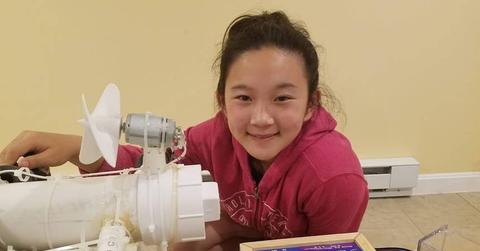12-Year-Old Girl Creates Robot That Detects Plastic In Our Oceans
A sixth-grader in Massachusetts has begun developing a robot that's able to detect microplastics in our ocean after wanting to make a difference at the Boston Harbor. Her ultimate goal is to create a way to also pick up trash and cut costs in the process.
Updated May 31 2019, 11:35 a.m. ET
Plastic waste has become such a significant issue, even a junior high student knows it’s an overwhelming task. Anna Du, a sixth-grade student from Massachusetts, is in the beginning stages of a robot that can help clean up plastic littler. It follows some of the other amazing entrepreneurial efforts to eliminate plastic waste, like Boyan Slat’s Ocean Cleanup project.
Du’s inspiration to create a cleanup solution of her own came when she wasn’t able to pick up all the pollution at the Boston Harbor. She wanted an easier process to retrieve the trash, creating a robot that uses underwater infrared light to track down microplastics. As development continues, she hopes the machine will have the ability to pick this trash up.
There’s been collaborative efforts like Litterati to help collect all kinds of pollution in our environment and provides unique data, such as how much trash can be found in an area and it can link what companies are responsible. Du’s project, at least in the initial stages, looks to give us further details on just how bad our oceans are polluted when it identifies plastic waste.
"One day when I was at Boston Harbor, I noticed there was a lot of plastics on the sand," Du told WSB Radio. "I tried picking some up, but there seemed to be so many more, and it just seemed impossible to clean it all up."
Plastic pollution in our waters continues to be a serious problem. Only a portion of it is caused by ships -- 80 percent of it comes from urban runoff, such as when it blows away from our trash cans, garbage trucks, or landfills. The Great Pacific Garbage Patch continues to collect enough pollution to be bigger than countries like France. Overall, there’s over five trillion pieces of plastic in the ocean.
The project was entered in a Young Scientist Lab challenge, created by Discovery Education and 3M. Du ended up being one of the 10 finalists and is mentored by one of the 3M scientists, Dr. Ann Fornof. Fornof is an advanced research specialist with a Ph.D in macromolecular science that helps commercialize the company’s products.
Du hopes to create a cleaning system that has a similar impact to Boyan Slat’s Ocean Cleanup machine. Over the next five years, it’s expected to clean up half of the Great Pacific Garbage Patch. This summer, Slat is planning to launch the first cleanup system and most recently has successfully conducted towing tests.
“[In 15 years, I hope to be an] engineer because I love the ocean and marine animals, and I want to do something to help,” Du told the Young Scientist Lab in a Q&A. “In the future, with my engineering, I hope to be able to save people with all of my inventions.”
A number of other unique projects made the cut at the Young Scientist Lab challenge. Leo Wylonis from Pennsylvania is working to limit aircraft carbon emissions through the use of pneumatic artificial muscles. Theodore Jiang from California is creating a new smartphone case that’s able to generate electricity from finger taps on the screen, essentially charging while you text, or as he calls it, “textricity.”
